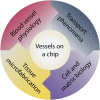Vessel-on-a-chip models for studying microvascular physiology, transport, and function in vitro
- PMID: 33176110
- PMCID: PMC7846973
- DOI: 10.1152/ajpcell.00355.2020
Vessel-on-a-chip models for studying microvascular physiology, transport, and function in vitro
Abstract
To understand how the microvasculature grows and remodels, researchers require reproducible systems that emulate the function of living tissue. Innovative contributions toward fulfilling this important need have been made by engineered microvessels assembled in vitro with microfabrication techniques. Microfabricated vessels, commonly referred to as "vessels-on-a-chip," are from a class of cell culture technologies that uniquely integrate microscale flow phenomena, tissue-level biomolecular transport, cell-cell interactions, and proper three-dimensional (3-D) extracellular matrix environments under well-defined culture conditions. Here, we discuss the enabling attributes of microfabricated vessels that make these models more physiological compared with established cell culture techniques and the potential of these models for advancing microvascular research. This review highlights the key features of microvascular transport and physiology, critically discusses the strengths and limitations of different microfabrication strategies for studying the microvasculature, and provides a perspective on current challenges and future opportunities for vessel-on-a-chip models.
Keywords: angiogenesis; cellular microenvironment; microfluidics; tissue microfabrication; vascular remodeling.
Conflict of interest statement
No conflicts of interest, financial or otherwise, are declared by the authors.
Figures



References
Publication types
MeSH terms
Grants and funding
LinkOut - more resources
Full Text Sources

